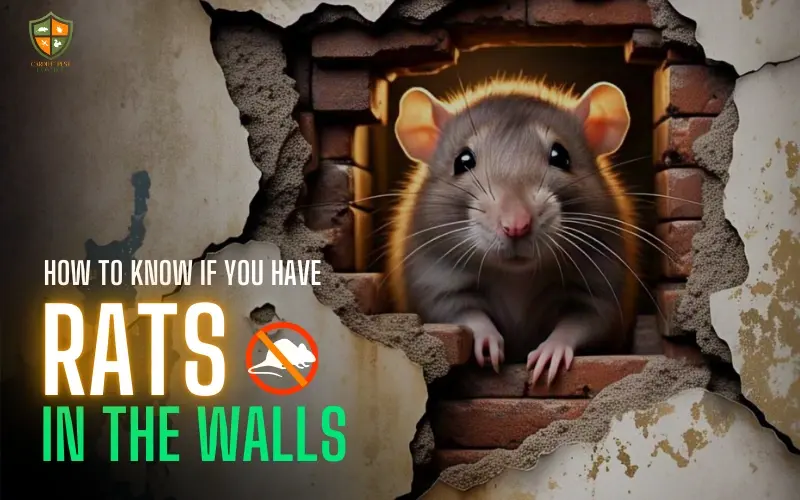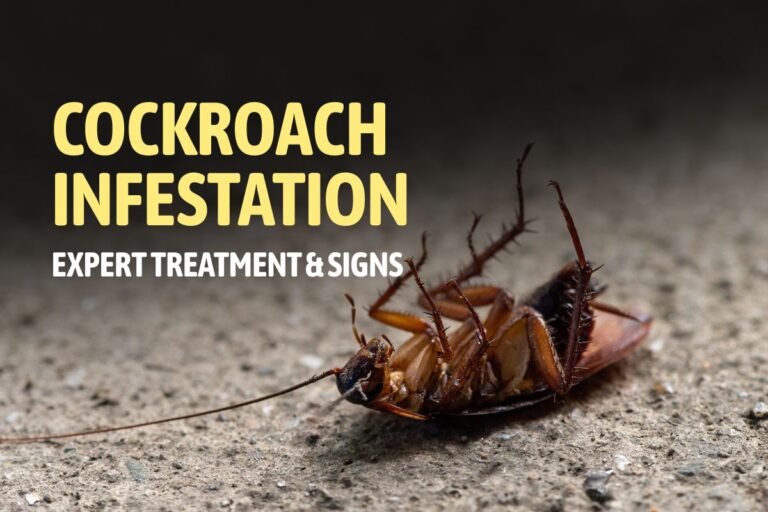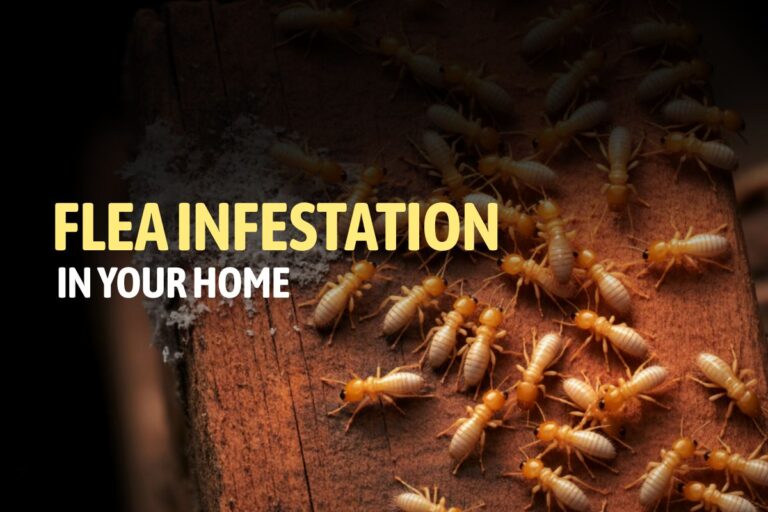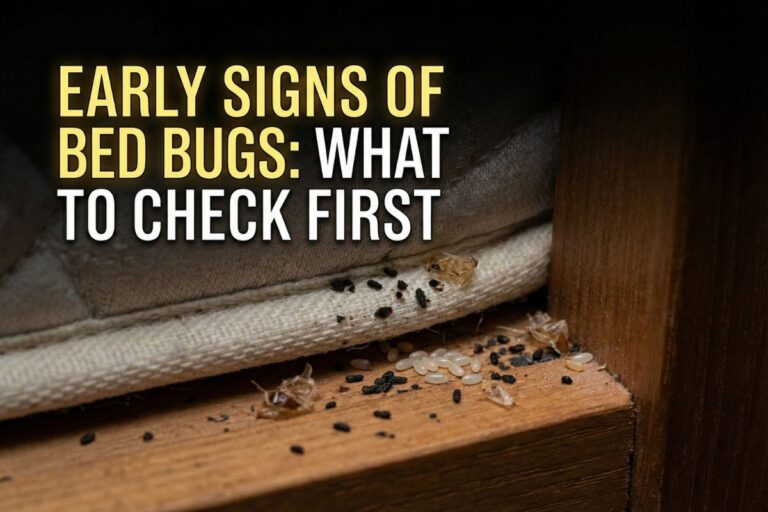Table of Contents
ToggleRats are clever at hiding, and when they find their way into your walls, they can stay there without being noticed for weeks or even months. During that time, they can chew through wires, wood, and insulation, causing serious damage to your home. Even worse, their droppings and urine can lead to health problems for your family. That’s why it’s so important to notice the early warning signs and take action quickly.
This guide will help you understand how to spot the signs of rats in walls, the dangers they bring, and the best ways to deal with them before the situation gets out of hand.
Why Rats Choose Walls as Hiding Spots
Walls offer rats an ideal environment: warmth, shelter, and easy access to food and water sources. Once they gain entry into a home through small holes, vents, or cracks, walls become the perfect hiding place.
Typical entry points include:
- Gaps near utility lines
- Cracks in the foundation
- Openings around windows and doors
- Roof vents or chimneys
Once inside, rodent activity in walls often goes undetected until damage or strange sounds begin to emerge.
Common Signs of Rats in Walls
Rats leave behind clear indicators when they’ve made your walls their home. Here are the most common signs of rats in walls:
1. Scratching Sounds in Walls
One of the earliest indicators is noise. At night, when the house is quiet, you might hear scratching sounds in the walls, gnawing, or even the soft scurry of feet. These noises typically come from attics, basements, or inside the drywall.
2. Chew Marks and Gnawing
Rats constantly gnaw to keep their teeth trimmed. This leads to visible chew marks on baseboards, electrical wires, and even plastic piping.
3. Droppings and Urine Odors
Rats defecate frequently. Their droppings resemble small, dark pellets. Over time, their urine also produces a strong ammonia-like odor.
4. Pet Behavior Changes
If your pets are suddenly staring or pawing at walls, they may be hearing or smelling rodent activity in the walls.
5. Grease Trails and Smudge Marks
As rats travel, the oil and dirt from their fur can leave visible marks along walls and entry points.
How to Detect Rats in Walls
If you suspect an infestation, you’ll want to confirm the presence of rats using these methods before proceeding with any Rat & Mice Extermination.
1. Listen Carefully
Nighttime is the best time to identify the noises rats make in the walls. Quiet your environment and listen in different rooms.
2. Use Flashlights and Inspection Tools
Shine a flashlight into wall openings, behind appliances, or inside attics to spot droppings, chew marks, or nests.
3. Tap the Walls
Sometimes, lightly tapping on the wall can trigger movement, revealing rodent activity in the walls.
4. Motion Sensors and Cameras
Set up low-cost cameras or motion sensors to capture movement near suspected entry points.
How to Tell If Rats Are in Your House
Beyond wall activity, rats often leave broader clues throughout the home. Here’s how to tell if rats are in your house:
- Scratching noises in the ceilings or attics
- Rat droppings in cupboards, pantries, or under sinks
- Chewed-up food packaging
- Nesting materials like shredded paper or insulation
- Sudden appearance of holes in walls or flooring
Regularly checking your attic, garage, and crawl spaces is essential to identify a rat infestation in the walls before it spreads.
The Dangers of a Rat Infestation in Walls
Having rats behind your walls is more than just a nuisance. The risks include:
1. Structural Damage
Rats chew through insulation, drywall, and even wood supports. Over time, this can weaken your home’s structure.
2. Electrical Hazards
Rodents gnawing on electrical wires can cause power outages and increase the risk of fire.
3. Health Risks
Rats can transmit diseases like leptospirosis, hantavirus, and Salmonella. Their urine and droppings can also trigger allergies and asthma.
4. Infestation Growth
A single pair of rats can multiply rapidly. Within months, a small issue can turn into a severe rat infestation in the walls.
How to Get Rid of Rats in Walls
Once you’ve confirmed that you’re dealing with rats in the walls, it’s important to act quickly and effectively. Ignoring the problem can lead to worsening damage, greater health risks, and a growing rat infestation in walls. Below is a comprehensive, step-by-step approach to get rid of rats and prevent future rodent activity in walls.
1. Seal All Entry Points
The first and most crucial step is to eliminate access. Rats in the walls often find their way in through tiny cracks, vents, or utility gaps. Carefully inspect the exterior and interior of your home:
- Use steel wool or metal mesh to plug small holes (larger than a quarter inch), especially around pipes, cables, and air vents.
- Seal cracks in foundations, brickwork, and siding using caulk or expanding foam.
- Check around door frames, window sills, and attic openings, and reinforce them if necessary.
- Install vent covers and chimney caps to stop rodents from entering through elevated points.
Rats can flatten their bodies to squeeze through very tight spaces, so be thorough.
2. Set Up Rat Control Measures
Once access is restricted, focus on eliminating the existing rodent activity in the walls. Traps are the most practical and immediate solution for homes:
- Mechanical snap traps are fast-acting and effective when placed along known runways or near wall edges.
- Electronic traps deliver a humane, high-voltage shock and are ideal for indoor use.
- Avoid using poison in walls—poisoned rats may die in inaccessible areas, leading to severe odor problems and attracting insects.
Always place traps in secure, concealed areas where pets and children can’t reach them.
3. Use Bait Strategically
Baiting is useful when paired with traps or bait stations. If you’re dealing with a persistent rat infestation in walls, targeted baiting may improve results:
- Use tamper-resistant bait stations approved for residential use.
- Place them near entry points or along walls where you suspect rodent activity in walls.
- Rotate bait types and monitor for consumption to ensure effectiveness.
- Always follow safety guidelines and local regulations when handling rodenticides.
Professional-grade bait stations are typically more effective and safer than over-the-counter products.
4. Clean and Disinfect
Eliminating rats in the walls isn’t complete until you thoroughly clean and sanitize affected areas:
- Wear gloves and a mask while cleaning to protect yourself from exposure to rat droppings and urine.
- Remove any nesting materials, droppings, and contaminated insulation.
- Use enzyme-based cleaners or a diluted bleach solution to disinfect surfaces and neutralize odors.
- Consider replacing heavily soiled insulation or drywall to eliminate health hazards and discourage future nesting.
5. Call in the Experts
Professional pest control services have the tools, experience, and techniques to eliminate rodent activity in walls quickly and safely.
When to Call a Pest Control Professional
DIY methods can help, but sometimes the problem is beyond your control. Contact professionals when:
- You hear loud or continuous scratching sounds in the walls
- There’s evidence of a growing rat infestation in the walls
- Pets behave erratically or find dead rodents
- You’ve tried traps and sealing with no success
Experienced exterminators can inspect every corner of your property and apply advanced solutions to efficiently eliminate rats in the walls.
Preventive Tips to Avoid Rodent Activity in Walls
Keeping rats out is just as important as removing them. Try these preventive tips:
- Seal cracks and crevices inside and outside your home
- Keep food in airtight containers
- Regularly take out trash and compost
- Trim tree branches and shrubs near your house
- Conduct seasonal inspections, especially during colder months
Consistency and cleanliness go a long way in keeping rats out of your home.
Conclusion
Dealing with rats in the walls can be stressful and damaging if ignored. Recognizing the early signs, like noises rats make in walls or scratching sounds in walls, helps you act before the infestation worsens. While DIY methods can offer short-term relief, professional help is often the most reliable solution.
At Cardiff Pest Control, we specialize in identifying and eliminating rodent activity in walls using safe and effective methods. Don’t let hidden rats destroy your peace of mind or your property.







